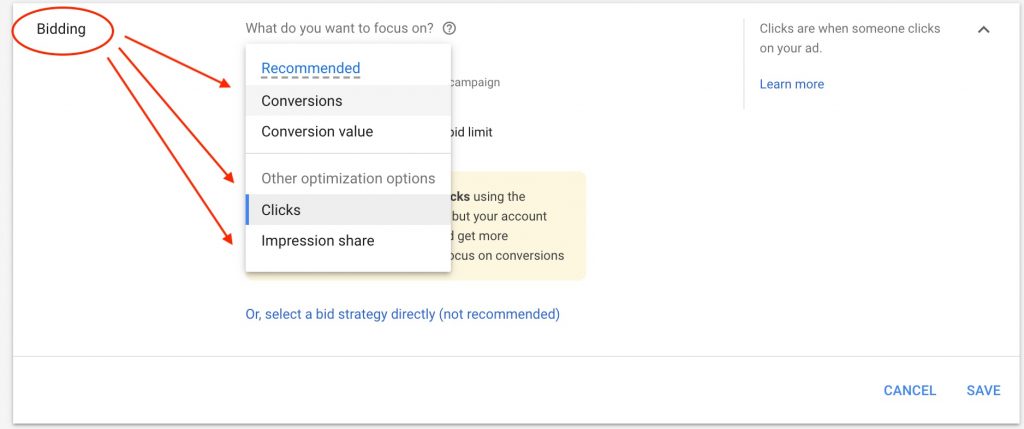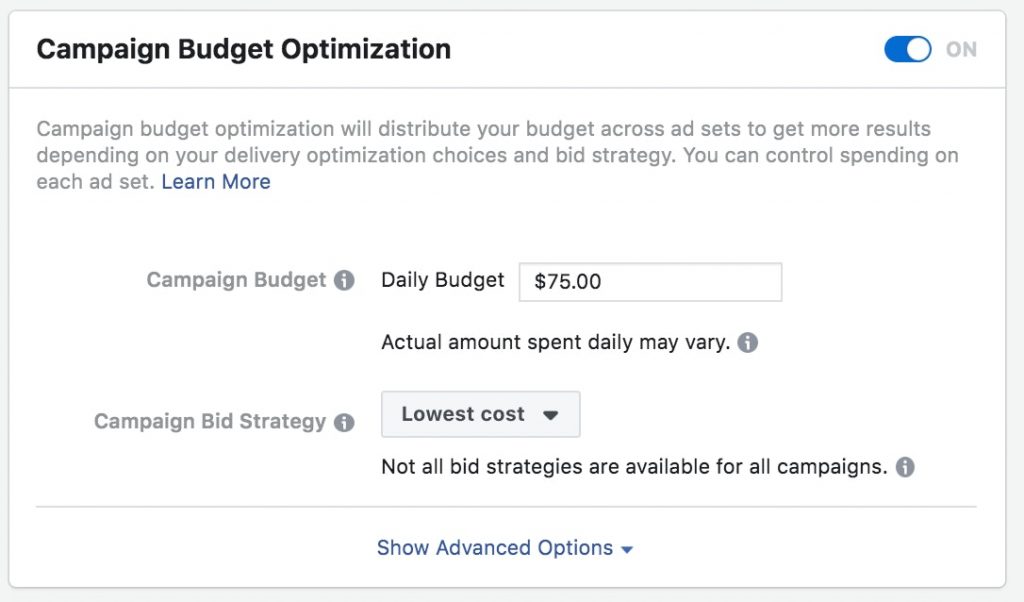Let’s talk about automated bidding strategies first.
When it comes to search, you really shouldn’t be bidding with manual CPCs anymore. Both Google and Microsoft platforms provide automated bidding strategies you can choose from that best align with the goals of the campaigns you’re running.
Let’s look at these automated bidding strategies and how they can help with your different goals below. All of these strategies increase and decrease your keyword bids in real time based on the likelihood it is able to achieve your target goal.
A few automated bidding strategies in Google Ads!
Setting a Target CPA to Lower Cost
As an example, let’s say your current cost per conversion is around $300 for a given campaign, but you need to get that down to around $200.
Setting a tCPA bid strategy for this campaign can help you achieve that. When setting a tCPA bid strategy, it’s important to note that you shouldn’t just set the target to $200 if you’re currently at $300. The most effective way to bring down your cost per conversion is to set the target about 20% lower than the current cost per conversion. So if you’re currently at $300, then you would want to start with a $240 tCPA target. Once the bid strategy has gotten you down to that $240 target, then you can lower to the $200 target.
This is just a broad example, and it is also very important to consider your campaign’s budget, and how many conversions it can efficiently generate within that budget amount based on your cost per conversion.
Using “Maximize Clicks” to…Maximize Clicks
You would want to consider using the Maximize Clicks strategy if you’re focused on getting as much as traffic to your landing pages as possible. When you’re setting up this bid strategy, you will need to set a maximum CPC or amount you are willing to pay for a click. The machine learning algorithms will take this into account and won’t raise your bids over that amount.
Increasing Conversions with “Maximizing Conversions”
The Maximizing Conversions strategy would be best used if you currently are not trying to optimize to ROI goals, and you just want to focus on generating as many conversions as you can within your budget. If you do have ROI goals and values assigned to your conversions, then it would be better to use a tCPA or Target ROAS bid strategy. Speaking of which…
Applying the Target ROAS Bid Strategy
You’d most likely use the Target Return on Ad Spend bid strategy if you’re running Shopping campaigns in Google. However, you can also use this for Google search campaigns, but only if you have values assigned to the conversions you are optimizing towards.
Responsive Search Ads
On the creative side of things for search, Google is heavily pushing an ad type called Responsive Search Ads.
Instead of putting your headlines and descriptions together like you normally would for text ads, you instead supply Google with up to 15 headlines and 4 descriptions. Over time, Google will then mix and match these different headlines and descriptions to test and find the combinations that perform the best on the different search queries that show for the keywords you are bidding on.
It’s important to monitor performance on these regularly. They may not perform as well as your standard text ads in the beginning, but you should start to see better performance on them as time goes on.
Let’s Talk Social: LinkedIn and Facebook Ad Automation
On the social side of things, Facebook and LinkedIn also have settings to automate your bidding so that you can focus more of your time on audiences and testing creative.
Speaking of creative, Facebook also allows for dynamic creative where you can submit multiple headlines, descriptions, and images together and they will test out the different combinations for you to see what creative combinations are performing better with your audience.
It’s important to know that if you are opting one of your Facebook ad sets into dynamic creative, you won’t be able to run any additional ads with that ad set.
Facebook: Campaign Budget Optimization (CBO)
Another automation feature Facebook has been testing over the last year or two is something they call Campaign Budget Optimization (CBO).
With this, you should be setting up all of your audiences in Facebook under one campaign (or more, depending on the different objectives you have with your campaigns). Then you set your budget at the campaign level, and Facebook’s algorithms will work to spend your budget more efficiently between your different audiences. They will move your budget in real time to the ad set or audience that is performing the best. Setting up your Facebook campaigns this way allows your budget to be fluid and move to what is performing best.
Automation Is the New Norm—Embrace It
Machine learning is allowing for more and more aspects of digital campaigns to become automated, so it’s important to make sure you’re staying in the know with new features. You especially want to be current with regards to Google and Facebook, as these two are the giants and usually lead the way for machine learning. If you’re a product-focused company, then keep up on Amazon too.
You want to opt into and test automation wherever you can so that you can spend more time testing audiences, creative, and platforms. The more you automate, the more knowledge you gain—and the easier it will be for you to efficiently market to your audiences.







